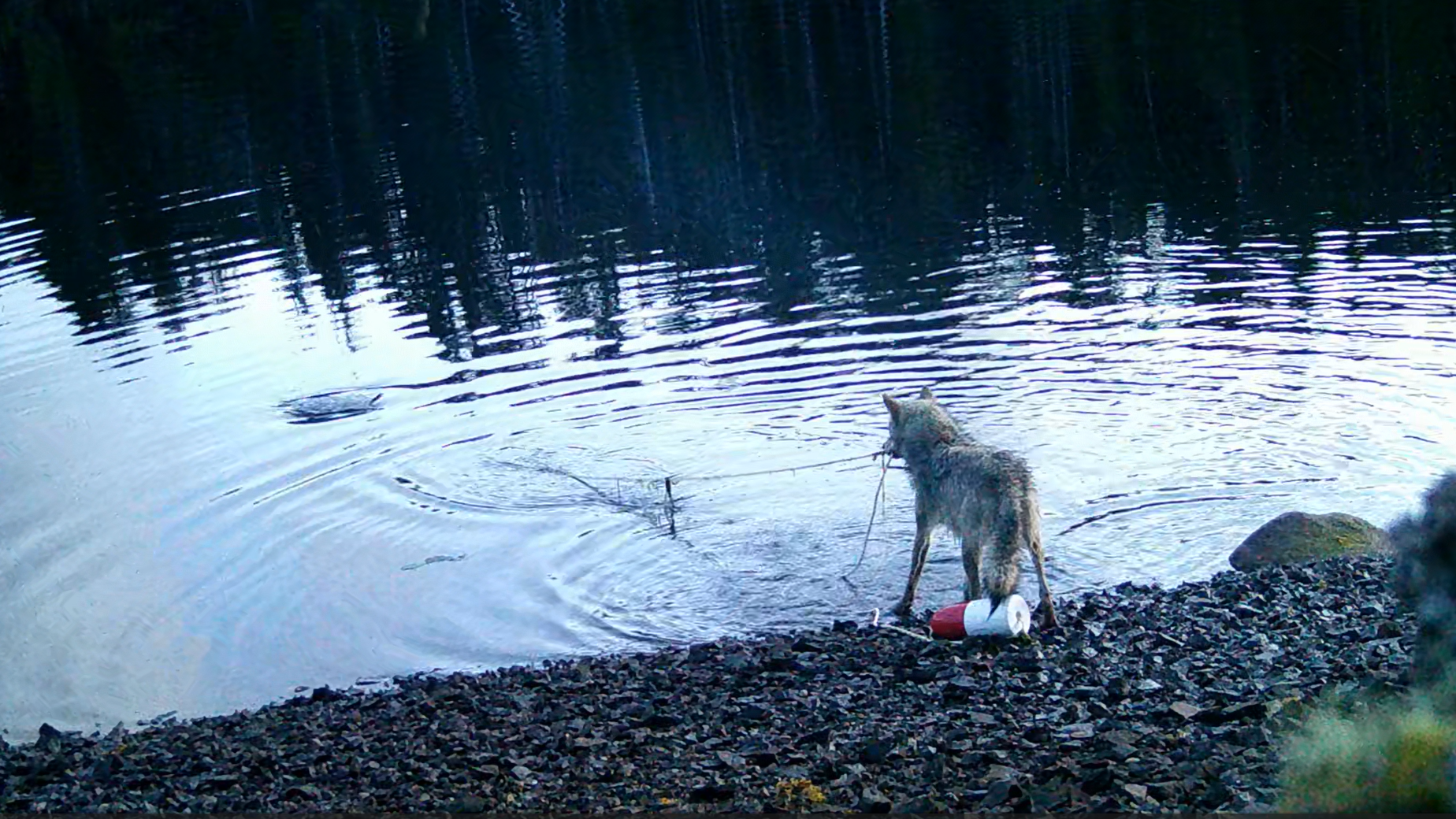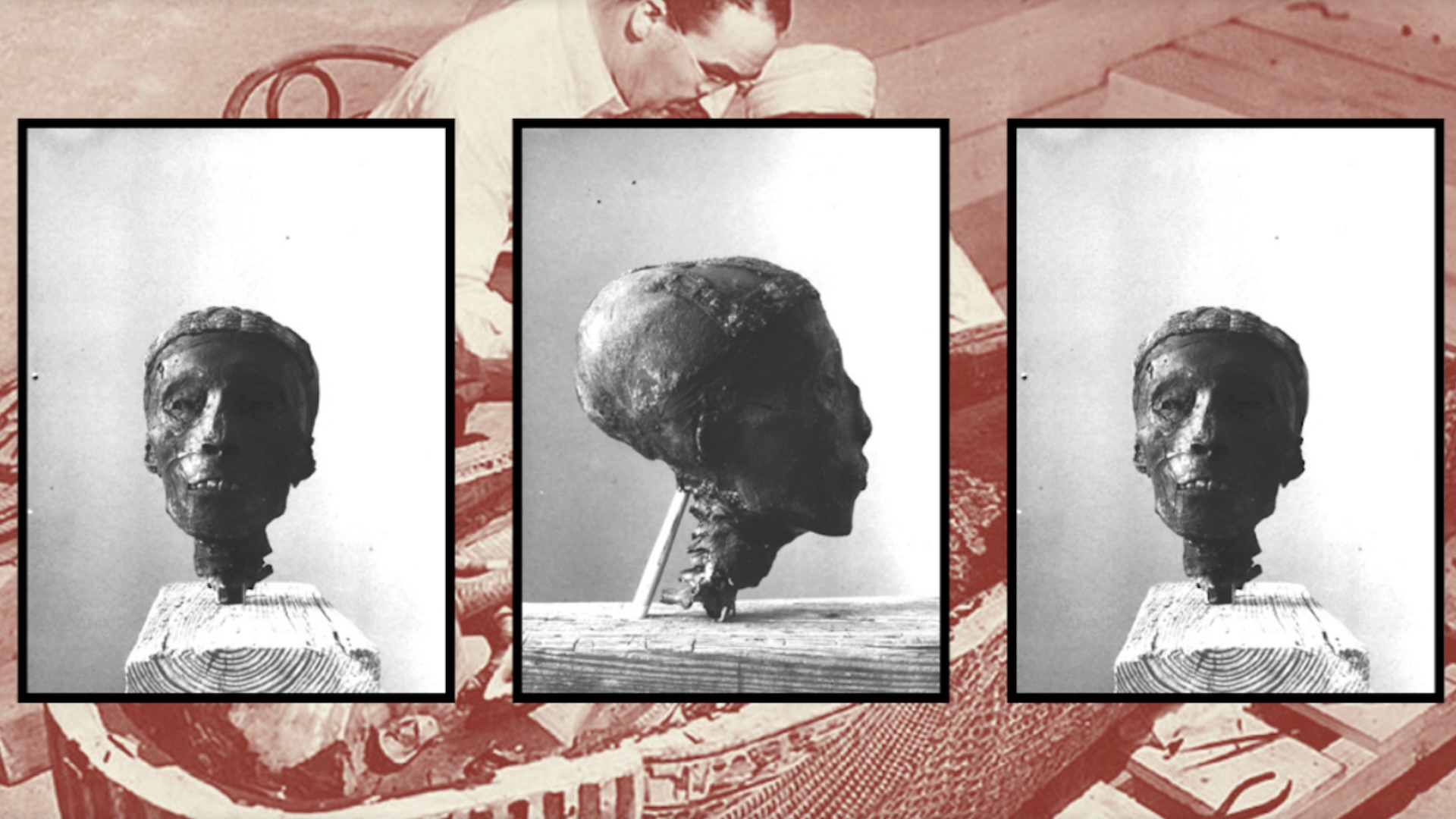Wolf stealing underwater crab traps caught on camera for the first time — signalling 'new dimension' in their behavior
A video has revealed never-before-seen behaviors in wolves that could mark the first case of tool use in a wild member of the wolf and dog family — and it was all for some crab bait.
Footage of a hungry wolf performing a complex sequence of behaviors on the coast of British Columbia could potentially mark the first case of tool use in wild canids.
The wolf swam into deep water to retrieve a floating buoy attached to a submerged crab trap. It couldn't see the crab trap, but seemed to know the trap was there and how the human tool worked — once back on shore, the wolf began to reel in the line that led to the trap, scientists explained in a new research paper. Finally, when the trap emerged from the water, the wolf broke it open and devoured the bait inside.
Wolves (Canis lupus) have been recorded interacting with human objects before, but this behavior was much more sophisticated than anything previously documented in these animals, according to the study, which was published Nov. 17 in the journal Ecology and Evolution.
"This is a new dimension of wolf behaviour we had not seen before," study lead author Kyle Artelle, an assistant professor at the State University of New York College of Environmental Science and Forestry, told Live Science in an email. "It shows how we have likely only scratched the surface of what the other species we share this world with can do, what and how they think, and what they can teach us."

The bait-snatching wolf lives within the Indigenous Haíɫzaqv Nation Territory on the central coast of British Columbia. These wolves spend a lot of time on the coast, with many relying on the sea for their food, according to the Haíɫzaqv Wolf and Biodiversity Project, which was responsible for the new research and which Artelle helps coordinate.
The new behavior was spotted because Haíɫzaqv Guardians, Indigenous people who conduct research and monitoring on behalf of their nation and the project, kept finding their crab traps damaged by an unknown predator. The crab traps are part of an attempt to eradicate invasive European green crabs (Carcinus maenas), which outcompete native crabs and generally disrupt Canada's marine ecosystems, so it's important for the traps to remain intact.
Initially, it was suspected that seals, sea lions or otters may have been responsible for the damage. A lot of the traps are placed in deep water and don't get exposed even at low tide, so it seemed likely that the culprit was a marine animal. However, within a day of the researchers deploying camera traps in May 2024 in attempts to identify the culprit, the wolf was caught red-pawed.
Get the world’s most fascinating discoveries delivered straight to your inbox.
Wolves have long had a reputation for being smart, but this footage could be the best example yet of their cognitive prowess, the researchers said.
"We realized this was important on the first watching," Artelle said. "Folks who know wolves well have always recognized how intelligent they are, but here is a video that really speaks for itself, that really highlights this clever behaviour, and shows us another aspect of the kinds of behaviours they can exhibit that we had not seen before."

The wolf's seemingly advanced intellect might not come as a surprise to owners of their domesticated pet cousins. Sophisticated behavior is well documented in dogs (Canis lupus familiaris), helped by the fact that we spend so much time with them. Researchers have even compared some dog behaviors, like learning the meaning of human words and gestures, to those of our famously quick-witted relatives, chimpanzees (Pan troglodytes), according to the study.
Researchers have also considered that dogs may be tool users, evidenced by behaviors such as moving chairs to [then jump on to in order to] access food. The same is potentially true for dingos, which have similarly been observed manipulating furniture in captivity. However, the authors couldn't find any reported tool use by a canid (member of the dog and wolf family) in the wild, which could make the wolf's clever feat the first case of wolf tool use captured on camera.
Tool use was once considered a unique trait of human intelligence. However, scientists have steadily dismantled this idea by documenting various nonhuman animals — including chimpanzees, capuchin monkeys and New Caledonian crows (Corvus moneduloides) — using tools. Of course, plenty of animals don't need to use tools, so the behavior is not necessarily the most reliable indicator of superior intelligence.
Precisely what constitutes tool use is debated among scientists, which muddies the new findings. Researchers generally accept that tool use involves the manipulation of an external object to achieve a specific goal with intent. However, some behaviors, like the pulling of a rope, can be excluded from definitions when the animals aren't deemed responsible for the rope's orientation, according to the study.
The wolf's use of a line to retrieve crab traps might be complex enough to be an exception to some researchers' rope exclusion rule. The problem is that the authors of the new study aren't sure what mechanisms are driving this newly observed behavior.
While the wolf appeared to have a sophisticated understanding of the unseen trap and its connection to the floating buoy above — potentially stemming from watching the Haíɫzaqv Guardians interact with the traps — the study doesn't rule out that the animals used a much simpler cognitive process: trial and error.
The camera traps, which are now a permanent feature in the Haíɫzaqv crab-hunting areas, have yet to capture a second incident of a wolf hauling up submerged bait. However, the researchers did retrieve some earlier clips that suggest one camera got tantalizingly close. The camera's footage opens with a dark wolf walking toward an exposed crab line that disappears off-screen. Once the wolf is out of shot, the line wobbles, and the next time the camera is triggered, the wolf is seen investigating the bait cups of two traps that have somehow made it to shore.

Patrick Pester is the trending news writer at Live Science. His work has appeared on other science websites, such as BBC Science Focus and Scientific American. Patrick retrained as a journalist after spending his early career working in zoos and wildlife conservation. He was awarded the Master's Excellence Scholarship to study at Cardiff University where he completed a master's degree in international journalism. He also has a second master's degree in biodiversity, evolution and conservation in action from Middlesex University London. When he isn't writing news, Patrick investigates the sale of human remains.
You must confirm your public display name before commenting
Please logout and then login again, you will then be prompted to enter your display name.
